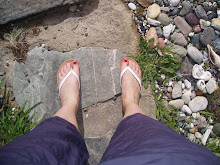Condition 2: Papulosquamous Dermatoses
Draft due: 27th July, Final due: 14th August, Peer assessment: 28th August 2009.
Description:
Contagious papulosquamous dermatoses are a group of skin diseases with various etiological factors, the most common types of which include tinea pedis (athlete's foot), tinea corporis (ringworm), scabies, and impetigo.
Considering that there are a wide variety of non-contagious papulosquamous dermatoses with similar signs and symptoms, it is best to ask the client if they are aware of their skin disorder and ask to see their medical records or refer on to get medical clearance before massaging them.
Etiology:
Ringworm & Tinea are both fungal infections caused by a group of fungi known as dermatophytes. Warmth and humidity are optimum factors for the onset of these conditions, ringworm can be transmitted from animals to humans, whereas athlete's foot can be transferred via skin contact and infected objects (Premkumar, 1999).
Scabies is caused by an infestation of the parasitic female scabies mite (sarcoptes scabiei) which is also transferred by skin to skin contact and close contact with contaminated towels, bedding, or hairbrushes.
Impetigo is caused by a streptococcus or staphylococcus bacterial infection which has breached the integumentary barrier (Schenck, 1999).
Signs & Symptoms:
Papulosquamous dermatoses are typified by a papule, inflammation and usually the development of a plaque on the surface (Mondofacto, 1998).
In the case of Ringworm a distinct red circular rash appears, resembling a ring. This lesion can be itchy or present a burning sensation.
Athlete's foot is identified by pale weeping skin between the toes and red, flaky crusted skin at the site of the infection. Again, this may itch or burn, and the plaque formed by this crusted skin can weep a clear discharge.
The presence of Scabies can be identified on close inspection as a tiny greyish burrow no more than 2-3mm in length which may have a visible mite at the end - usually a tiny dark dot (Fleisher, Ludwig & Silverman, 2002). This may not be visible to the naked eye, so the MT may look at other symptoms such as intense itching and as a result redness, where the affected skin has been repeatedly scratched. A skin scraping is the usual medical procedure for determining whether a scabies infestation is present.
When impetigo is present, flat blisters are visible which rupture and as a result, crusts may emerge in a clustered group (Schenck, 1999).
Morphology:
If left untreated, the fungal infections of ringworm and athlete's foot can complicate, resulting in secondary bacterial infections particularly in the case of an impaired immune system. The itching may lead to repeated scratching at the lesions which will irritate them, potentially spreading the fungus via the fingers and nails, and further destroying the integumentary barrier of the skin (Thiers, Sahn & Callen, 2009).
The female scabies mite lays eggs at the end of its burrow in the skin, thus rapidly increasing the scabies population over a relatively small time. Optimum warmth and during night hours while the client is sleeping tend to encourage the growth of the infestation population, as this is when they are most active (Fleisher et al, 2002).
As Impetigo is contagious, it is most often transferred to the face via the hands and vice versa. In the case that it reoccurs after treatment, it may be that the bacteria have been lying dormant in the nostrils, in which case a topically administered antibiotic is necessary (Fry, 1997).
Incidence & Prevalence:
The incidence for Impetigo and similar fungal infections is higher in warm, humid and tropical climates providing an optimum breeding ground for bacterial infection, occurring most commonly in school age children and teenagers (Bracker, 2001).
In the US and Europe, Scabies appears to occur in cycles of infestation spanning 3-4 decades, in 0-6% of the population (Nelson & Woodward, 2006).
Indications for MT:
If the skin disorder has been examined and cleared by a medical professional as being non-contagious (e.g. psoriasis, pityriasis rosea, excema) the patient may benefit from massage, provided the total area of affected skin is not large (Mitchell & Penzer, 2000). In this case, massage over the unaffected areas can assist with the patient's healing process (Werner & Benjamin, 1998), allowing for the circulation of lymph, and the positive result this could have on non-contagious skin disorders which may have an underlying immune connection, ie. sores that appear as a result of the immune system in distress (Thiers et al, 2009).
Contraindications for MT:
Tinea Corporis (Ringworm), Tinea Pedis (Athlete's Foot), Scabies and Impetigo are all contagious skin disorders, therefore if the client presents with any of the symptoms listed here (such as itching, redness and the appearance of crusted lesions), all skin to skin contact is contraindicated until treatment has ended and medical clearance is obtained.
Reference List:
Bracker, M. (2001) The 5-minute Sports Medicine Consult. US: Lippincott Williams & Wilkins, p. 460.
Elluminate session 2. (18th June, 2009) Otago Polytechnic Massage Therapy Diploma Course.
Fleisher, G., Ludwig, S. & Silverman, B. (2002) Synopsis of Pediatric Emergency Medicine. US: Lippincott Williams & Wilkins, p. 203.
Fry, L. (1997) An Atlas of Dermatology. London: Taylor & Francis, p. 83.
Mitchell, T. & Penzer, R. (2000) Psoriasis at your fingertips: the comprehensive and medically accurate manual on managing psoriasis. London: Class Publishing Ltd, p. 74.
Mondofacto. (1998) Skin Diseases: Papulosquamous. Retrieved on the 8th July, 2009 from: http://www.mondofacto.com/facts/dictionary?query=skin+diseases%2C+papulosquamous&action=look+it+up
Nelson, A. & Woodward, J. (2006) Sexually Transmitted Diseases: A Practical Guide for Primary Care. New York: Humana Press, p.269.
Premkumar, K. (1999) Pathology A - Z: A Handbook for Massage Therapists. Calgary: Lippincott Williams & Wilkins.
Schenck, R. (1999) Athletic Training and Sports Medicine. New York: Jones & Bartlett Publishers, p. 572.
Thiers, B., Sahn, R. & Callen, J. (2009) Cutaneous Manifestations of Internal Malignancy. CA: A Cancer Journal for Clinicians, 59 (2).
Werner, R. & Benjamin, B. (1998) A Massage Therapist's Guide to Pathology. Michigan: Williams & Wilkins.
